Tips to create the best elevator pitch presentation (with templates)

We’ve all been there – those brief, unexpected moments when you find yourself face-to-face with someone who could change the trajectory of your career. It could happen in an elevator, at a networking event, or even in line for coffee. In these fleeting moments, having a sharp, persuasive elevator pitch can make all the difference. But how do you distill the essence of your idea, product, or service into just a minute or two? How do you ensure your message is compelling enough to spark interest and leave a lasting impression?
Crafting a powerful elevator pitch deck is both an art and a science. It requires clarity, brevity, and a deep understanding of what makes your proposition unique. Whether you're seeking investment, pitching a new idea to your boss, or simply trying to network, a well-crafted elevator pitch can open doors and create opportunities you never thought possible. This article delves into the essentials of creating an engaging elevator pitch presentation, offering practical tips, examples, and insightful case studies to guide you through the process.
What is an elevator pitch?
An elevator pitch is your golden opportunity to make a first impression – a brief, persuasive speech designed to spark interest in what you or your organization does. The name comes from the idea that it should be short enough to deliver during a quick elevator ride, typically ranging from 30 seconds to 2 minutes.
The essence of an elevator pitch lies in its ability to convey your value quickly and effectively, making the listener want to know more. Think of it as your verbal business card, a snapshot of who you are, what you offer, and why it matters.
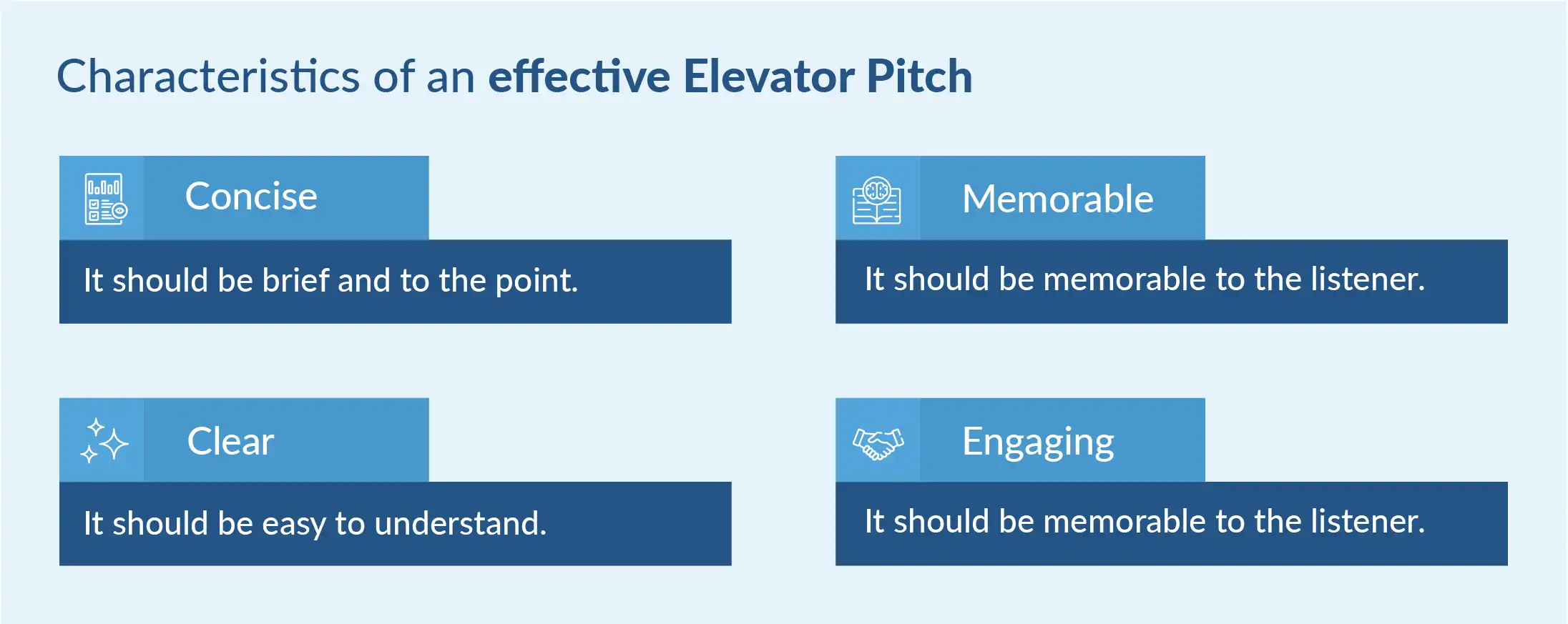
Basic components of an effective elevator pitch
Creating a great elevator pitch deck involves several key components. Each element plays a critical role in ensuring your message is clear, engaging, and memorable.
The Hook
Your hook is the opening statement designed to grab attention. It should be intriguing and relevant, making your audience want to hear more. This is where you set the tone for your pitch, so it needs to be compelling. You might start with a surprising statistic, a thought-provoking question, or a bold statement. The goal is to spark curiosity and draw your listener into your narrative. An effective hook not only captures interest but also sets the stage for the rest of your pitch.
The Problem
Next, you need to clearly define the problem your idea, product, or service addresses. This shows that you understand the pain points of your target audience and sets the stage for your solution. By articulating the problem, you demonstrate empathy and insight into your audience’s needs. This step is crucial because it establishes relevance and makes your listener care about what you’re about to present. The more specific and relatable the problem, the more engaged your audience will be.
The Solution
Now that you've laid out the problem, it’s time to describe how your offering solves it. This is your chance to highlight the unique features and benefits of your solution. You should explain what makes your approach different and why it’s the best option available. Be clear and concise, focusing on the value your solution brings. This part of your pitch should make your listener see the potential impact of your offering and envision how it can address their needs or challenges.
The Market
Identifying your target market and the potential for growth demonstrates that there is a demand for your solution and that you have a clear focus. This shows that you’ve done your homework and understand the landscape in which you’re operating. Discussing your market also helps to build credibility, as it indicates that you have a realistic and informed view of your business environment. It’s important to convey who your ideal customers are and why they need your solution.
The Value Proposition
Your value proposition is the specific benefit your solution brings to the table. This could be cost savings, time efficiency, or any other advantage that sets you apart from competitors. Your value proposition should be compelling and easy to understand, making it clear why your audience should be interested. It’s about communicating the unique benefits that make your offering stand out and why it’s worth considering. This part of your pitch needs to resonate strongly with your audience’s needs and desires.
The Call to Action
Finally, conclude with a clear call to action. What do you want your audience to do next? Whether it’s scheduling a meeting, visiting your website, or trying your product, your call to action should be direct and achievable. This step is essential because it guides your listener towards the next steps and keeps the momentum going. A strong call to action turns interest into action and opens the door for continued engagement.
Crafting each of these components thoughtfully and integrating them seamlessly into your pitch can make all the difference. Remember, the goal is to leave a lasting impression and to make your listener want to learn more about what you have to offer.

How long should an elevator pitch presentation be?
The length of an elevator pitch can vary depending on the context, but the general rule is that it should be short enough to deliver in the time it takes to ride an elevator, hence the name. This typically means:
- 30 seconds to 1 minute: For networking events or casual encounters.
- 1 to 2 minutes: For formal presentations or investor pitches.
Why keep it short?
Attention spans are shorter than ever!
These days, most people have a limited amount of time to devote to any single interaction, especially in casual settings. By keeping your pitch short, you respect your listener’s time and increase the chances of maintaining their attention. A concise pitch helps ensure that your key points are heard and remembered.
Clarity is crucial
Brevity forces you to distill your message down to its most essential components. This clarity is crucial because it helps you avoid overwhelming your listener with unnecessary details. When you focus on the core of your message, it becomes easier for your audience to grasp and retain the information. A clear and concise pitch ensures that your value proposition is understood and appreciated.
To be remembered
A well-crafted, succinct pitch is more likely to be remembered and repeated. When you deliver a concise pitch, you make it easier for your listener to recall and share your message with others. This memorability can lead to further discussions and opportunities as your pitch lingers in the minds of those who hear it. A memorable pitch increases the likelihood of follow-up conversations and actions.
Tips to create a successful elevator pitch presentation
Creating an effective elevator pitch presentation involves structuring your content into concise and engaging sections to capture and maintain your audience's attention. Here's a breakdown of the sections, much like a seasoned novelist would, ensuring each part leaves your audience eager for more.
1. The opening scene: Introduction
Starting your elevator pitch with a strong introduction sets the tone for the entire presentation. Instead of resorting to startling statements that might distract rather than engage, aim for a natural, informative opening that captures the essence of your business.
Begin by introducing your business name and providing a concise summary in no more than two sentences. This brief overview should give a clear snapshot of what your business does. If relevant, include a breakdown of your top three products or services to give a quick glimpse of your offerings. Clearly defining your target audience is essential unless it is evident, such as in the case of social media platforms that cater to everyone.
Make sure this introduction is brief and to the point—ideally, no more than 18 seconds or 36 words. This ensures the potential investor or listener grasps the core of your business swiftly and effectively.
💡 Pro tip: Consider beginning with a thought-provoking question or an interesting fact for an extra engaging start. This can serve as a powerful hook that draws your audience in from the outset. You can then follow this with your concise introduction on the next slide.
Example 1 - Starting with a Question

Example 2 - Starting with a Hook or Interesting Fact
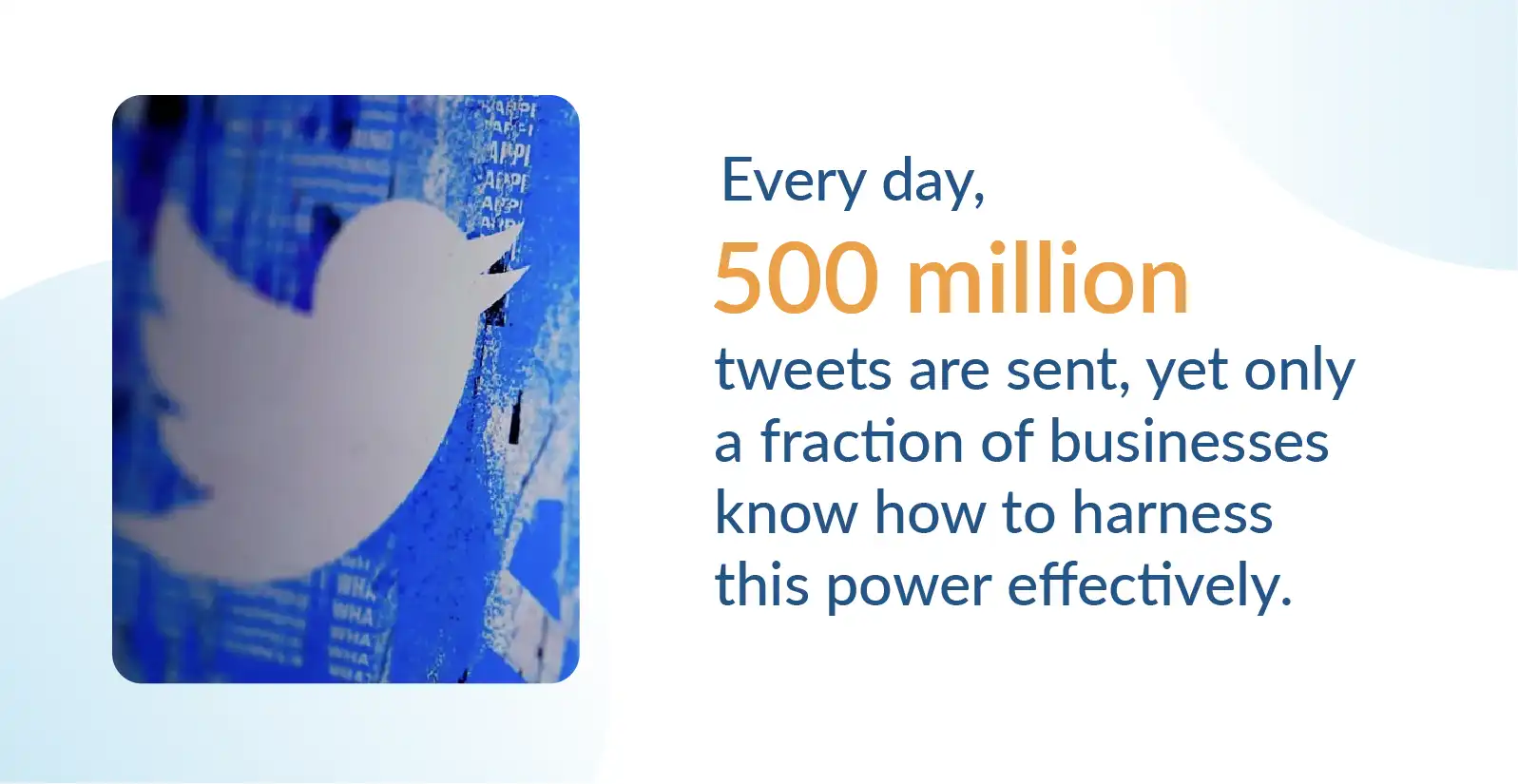
2. The conflict & resolution: Problem vs. Solution
In this section, your goal is to clearly articulate the problem your business aims to solve. This could be a single, significant issue, a series of smaller but related challenges, or one main problem broken down into a few key components.
The primary objective here is to show that you have a deep understanding of the challenge at hand. Clearly define the problem in a way that is straightforward and easy to grasp. Then, seamlessly transition into presenting your solution. The more straightforward and understandable your explanation, the more compelling it will be.
Whether you focus on one major issue or a few interconnected ones, make sure your audience can see the relevance and urgency of the problem. This sets the stage for you to introduce your innovative solution, highlighting how it effectively addresses the challenge. Simplicity and clarity are your allies that make a strong impact.
💡 Pro tip: Use real-life examples or data to illustrate the problem. This not only makes the issue more tangible but also adds credibility to your pitch. When your audience can see the real-world impact of the problem, your solution becomes even more compelling.


3. Setting the scene: Market size & competition
Potential investors are drawn to opportunities that promise significant returns. Therefore, it's crucial to illustrate the scale of the opportunity your business presents and provide insights into the competitive landscape. This gives investors an immediate sense of whether your venture is worth their time and resources.
By detailing the market size, you demonstrate the potential for growth and the vast possibilities for your business. Additionally, highlighting your understanding of the competition shows that you are well-prepared and have a clear strategy to stand out in the market. This dual focus on opportunity and competition sets a solid foundation for investors to see the viability and potential profitability of their investment.
Example:
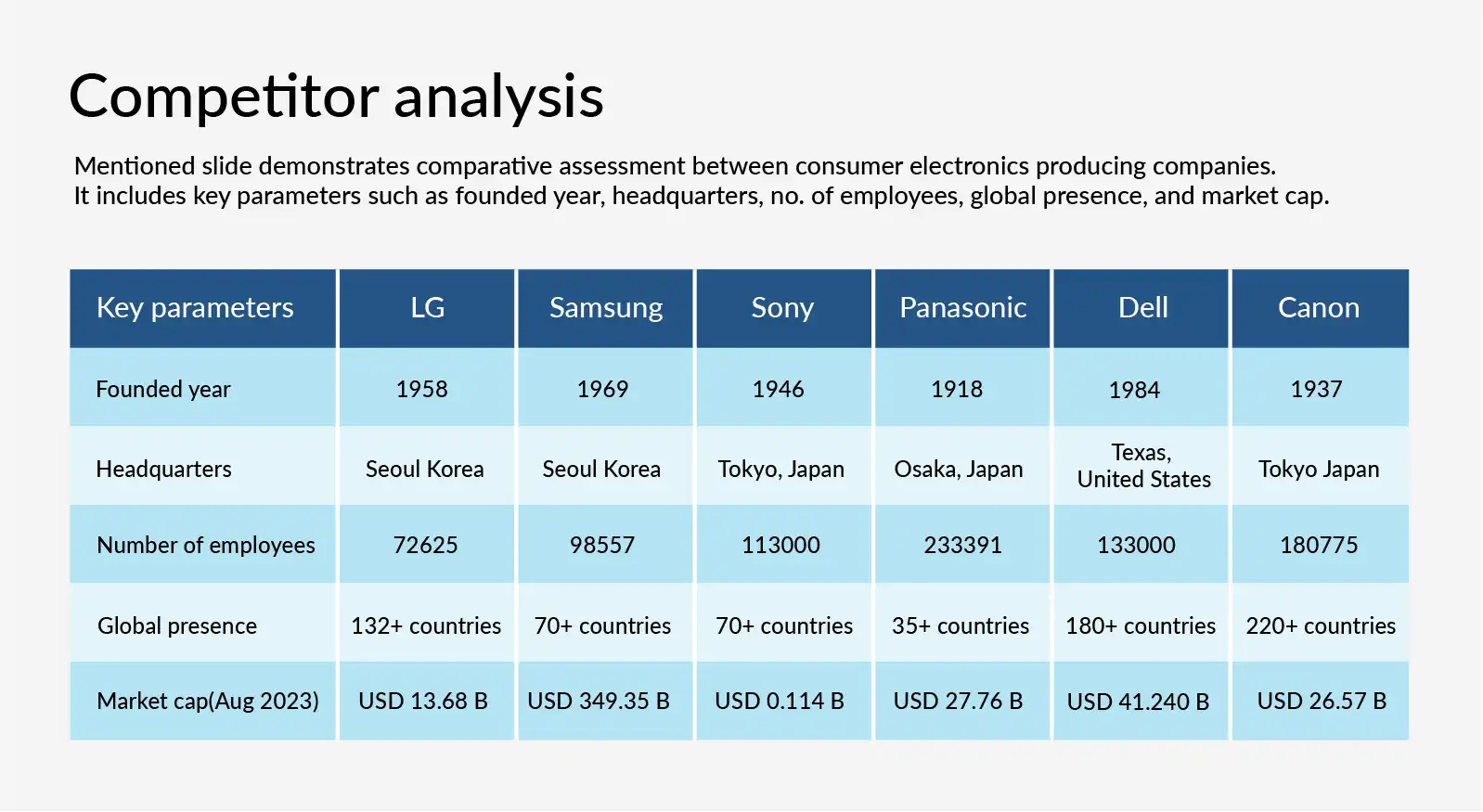
💡 Pro tip: Use visual aids like charts and graphs to present market size and competitive analysis. Visual representations can make complex data more digestible and impactful, helping investors quickly grasp the potential and positioning of your business.
4. Business Model: How the story unfolds
A concise elevator pitch slide on your business model can quickly show investors how you plan to generate revenue. When your business strategy is clear and compelling, it significantly increases the likelihood of attracting investors. Presenting a well-defined business model demonstrates that you have a thoughtful and viable plan for profitability, making your venture more appealing and reducing perceived risks.
💡 Pro tip: Include key metrics and financial projections to back up your business model. Showing potential revenue streams, cost structures, and profitability timelines with concrete numbers can add credibility and help investors understand the financial potential of your business.
Example:
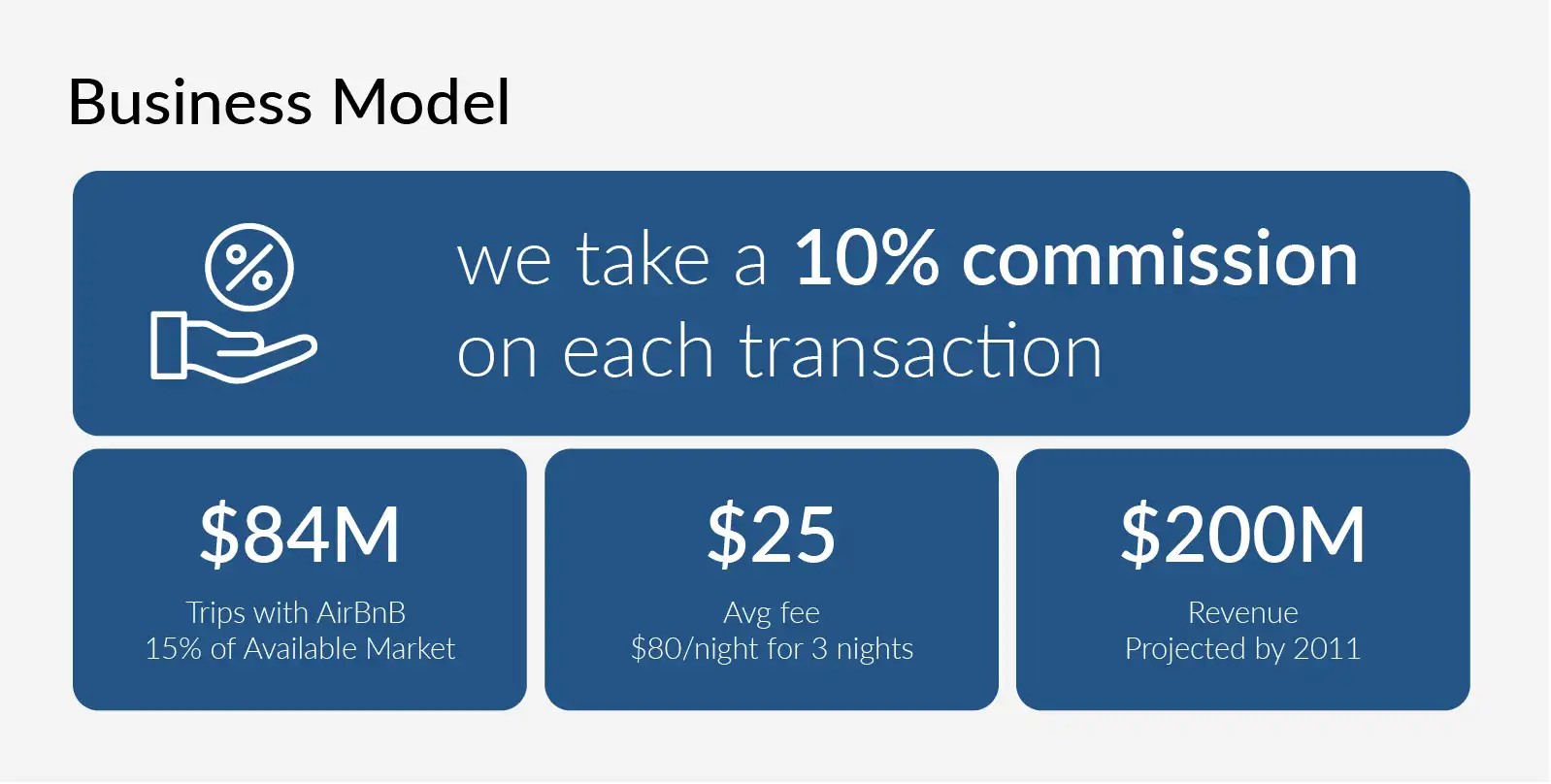
5. The twist in the tale: Unique selling point (USP)
In this section, your goal is to showcase what makes your company unique and how it stands out from the competition. This is a crucial moment where potential investors decide whether to delve deeper into your business.
If you can capture their interest here, the chances of securing a follow-up meeting and, ultimately, funding increase significantly.
💡 Pro tip: You have a maximum of 20 seconds to highlight your USP, so keep your information concise and focused. Emphasize only the most critical details that your investors need to know.
.webp)
Additionally, if your product or solution involves advanced technology, consider adding a slide that explains it. If you have patented technology, make sure to highlight this aspect during your pitch. This not only demonstrates innovation but also adds a layer of credibility and competitive advantage.
6. The characters: Founding team
People invest in people. Investors want to know the credentials and backgrounds of the individuals behind the business. To build trust and confidence, always highlight your team's credentials, experience, and significant accomplishments. Showcasing the strengths and expertise of your founding team not only adds credibility but also reassures investors that their money and effort are in capable hands.
7. Plot points: Money milestones
Investors are captivated by numbers and will recall them long after your pitch ends. To leave a lasting impression, clearly outline your financial milestones and investment strategy from the outset. Demonstrating a well-thought-out financial plan highlights your business's growth trajectory and reassures investors of your strategic foresight.
Example:
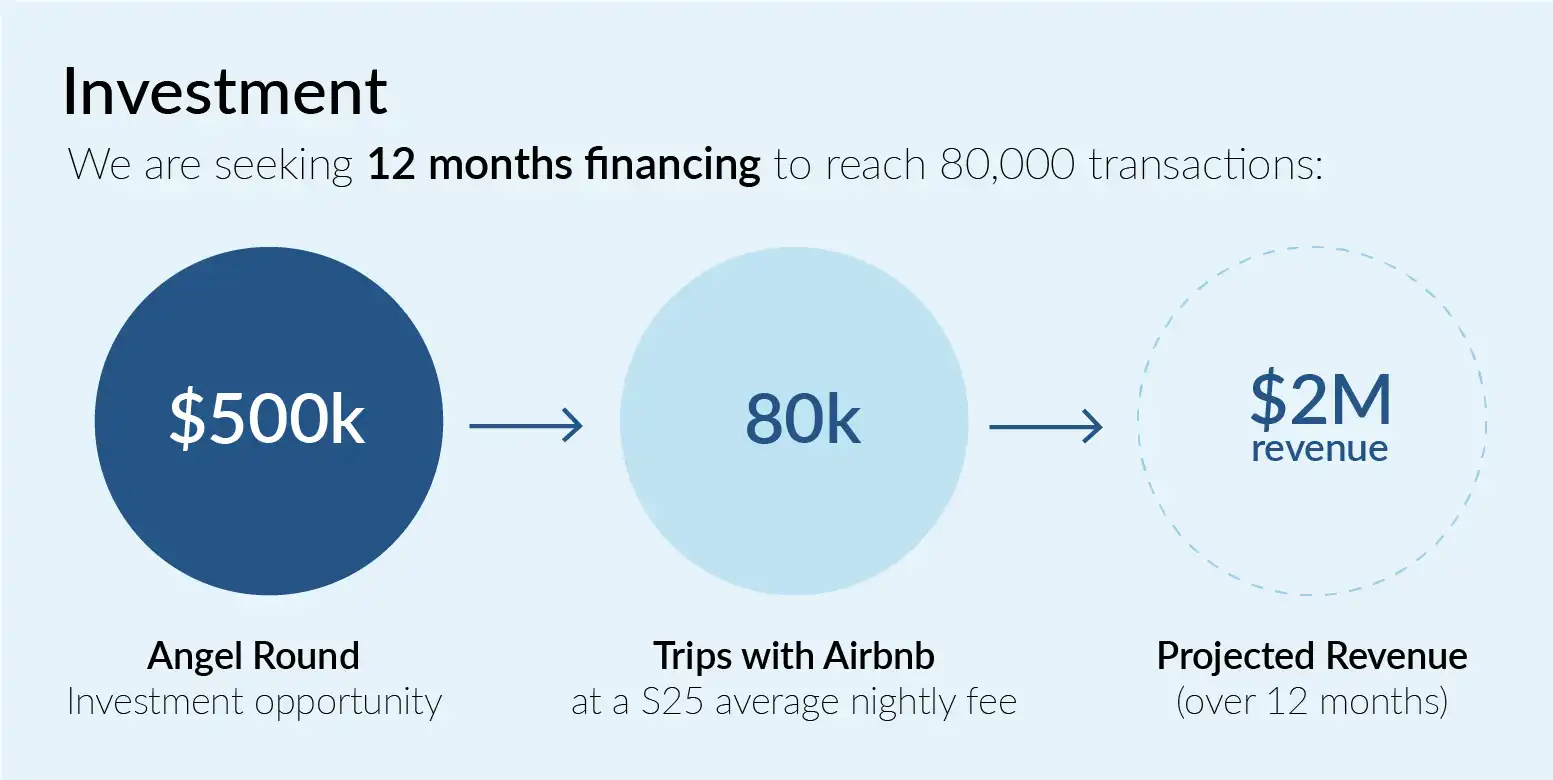
8. The closing appeal: Call to action
Ending your elevator pitch with a strong call to action (CTA) is essential as it generates excitement and creates a sense of urgency. A well-crafted CTA can inspire your audience to take the next step, whether it's learning more about your business or starting a partnership.
Consider these impactful CTAs:
- Visit our website
- Follow us on Facebook
- Drop by our store
- Explore our brochure
- Sign up for our newsletter
- Contact us for more information
- Invest in our company
- Partner with us
By including a clear and compelling CTA, you guide your audience toward the desired action and keep the momentum going.
💡 Pro tip: Make your CTA specific and actionable. Instead of a generic request, provide clear instructions or direct links that make it easy for your audience to follow through.
Bonus: Quick do's and don'ts
Crafting an effective elevator pitch is as much about what you say as how you say it. Here are some quick do's and don'ts to ensure your pitch resonates:
Do's:
- Keep it Simple: Use clear, straightforward language. Avoid truisms, buzzwords, and jargon that can confuse your audience.
- Be Concise: Stick to the key points. Weed out fillers and unnecessary details.
- Personalize Your Pitch: Tailor your pitch to your audience and refresh it as the situation changes.
- Maintain High Energy: Speak with enthusiasm and energy to keep your audience engaged.
- Create a Memorable Conclusion: End with a catchy phrase, a promise of value, or a summary that will stick in the investor’s mind.
Don'ts:
- Avoid Hyperbole: Steer clear of exaggerated claims that can undermine your credibility.
- Don’t Rush: Speak at a steady, clear pace to ensure your message is understood.
- Skip the Monotone: Avoid speaking in a flat, monotone voice. Show enthusiasm and smile.
- Don’t Overwhelm Your Audience: Avoid giving your pitch to people who seem uninterested or in a hurry.
- One-Size-Fits-All Approach: Don’t use the same pitch for every situation; adapt as needed.
Speaking Tips:
- Stay Relaxed: Keep a relaxed and steady rhythm in your elevator speech to convey confidence and credibility.
- Time Management: Be mindful of the time, but don't let it make you rush. A clear and steady delivery is more effective.
- Creative Ending: Conclude with a memorable statement or question. This could be a catchy phrase, a promise of value, or an invitation for further discussion.

Best elevator pitch examples to inspire
Creating an effective elevator pitch can be challenging, but seeing how successful companies might craft their pitches can provide valuable insights. Here, we’ll explore hypothetical examples from Airbnb and LinkedIn to illustrate how they could effectively communicate their value propositions.
Airbnb
An elevator pitch for Airbnb could resonate with travelers seeking unique experiences beyond the offerings of traditional hotels.
Hook: “Imagine wanting to explore the world authentically but struggling to find affordable and unique accommodations.”
Problem Statement: “Traditional hotels are expensive and often don’t provide the local experience travelers crave.”
Solution: “Airbnb connects travelers with local hosts who offer unique, affordable accommodations in their homes.”
Unique Value Proposition: “Unlike hotels, Airbnb offers a wide variety of unique spaces, from treehouses to castles, giving travelers a truly local experience.”
Call to Action: “Check out our website to find your next unique stay or become a host today.”
An elevator pitch for LinkedIn might emphasize the efficiency and effectiveness of their platform in meeting the professional networking needs of today’s workforce.
Hook: “Professionals need a way to connect and network in today’s digital world.”
Problem Statement: “Traditional networking methods are time-consuming and often ineffective.”
Solution: “LinkedIn is a professional networking platform that connects you with colleagues, industry leaders, and potential employers.”
Unique Value Proposition: “With LinkedIn, you can showcase your professional achievements, find job opportunities, and build valuable industry connections.”
Call to Action: “Join LinkedIn today and start building your professional network.”
By analyzing these hypothetical examples, it becomes clear that a successful elevator pitch requires a strong hook, a clear problem statement, a concise solution, a compelling, unique value proposition, and a direct call to action. Each element works together to create a pitch that is both engaging and persuasive, ultimately driving the listener to take the next step.
Frequently asked questions (FAQs)
Q: What are the different types of elevator pitches?
A: Elevator pitches can vary based on their purpose and audience. Common types include:
- Startup Pitch: Focuses on the core idea, market potential, and unique selling points of a startup.
- Sales Pitch: Emphasizes the features and benefits of a product or service to persuade potential customers.
- Networking Pitch: Aimed at building connections and briefly highlighting your professional background and goals.
- Investor Pitch: Designed to attract investment by detailing the business model, market opportunity, and financial projections.

Q: How does a sales pitch differ from an elevator pitch?
A: While both aim to persuade, a sales pitch is typically more detailed and focused on convincing potential customers to purchase a product or service. It often involves explaining features, benefits, and addressing objections. An elevator pitch, on the other hand, is a brief, high-level overview designed to spark interest and lead to further conversation.
Q: How long should an elevator pitch be?
A: An elevator pitch should typically be between 30 seconds to 2 minutes, depending on the context. For casual encounters or networking events, aim for 30 seconds to 1 minute. For more formal presentations or investor pitches, you can extend it to 1 to 2 minutes.
Q: What are some common mistakes to avoid in an elevator pitch?
A: Common mistakes include using too much jargon, speaking too quickly, providing too much information, and failing to engage the audience. It's essential to be clear, concise, and to the point, ensuring your message is easily understood and remembered.
Q: How can I make my elevator pitch more engaging?
A: To make your pitch more engaging, start with a strong hook, use relatable language, and tell a compelling story. Incorporate visual aids if possible, and always end with a clear call to action. Practice delivering your pitch with enthusiasm and confidence.

Q: Should I tailor my elevator pitch to different audiences?
A: Yes, it's crucial to tailor your pitch to different audiences. Consider the interests and needs of your audience and adjust your pitch accordingly. Personalizing your pitch can make it more relevant and impactful.
Q: How can I practice my elevator pitch effectively?
A: Practice your pitch in front of a mirror, record yourself, and seek feedback from friends or colleagues. Rehearse in different settings and situations to ensure you can deliver it smoothly and confidently. The more you practice, the more natural and effective your pitch will become.
Q: How can I write an elevator pitch for a job interview?
A: To craft a compelling elevator pitch for a job interview as a job seeker, focus on highlighting your key strengths, relevant skills, and career achievements. Start by briefly introducing yourself and your background in a manner that is short and to the point. Then, concisely explain what makes you a strong candidate for the position, emphasizing your unique value proposition and how your experience aligns with the job requirements. End with a clear call to action, such as expressing your enthusiasm for the role and inviting further discussion.
Q: What are the key components of an elevator pitch template for a business pitch?
A: An effective elevator pitch template for a business pitch should include the following components:
- The Hook: A compelling opening statement to grab attention.
- The Problem: A clear description of the problem your business addresses.
- The Solution: A brief overview of your solution and its benefits.
- The Market: Information on your target market and potential growth.
- The Value Proposition: The unique benefits of your solution.
- The Call to Action: A direct request for the next step, such as scheduling a meeting or visiting your website.
Q: How can a project management professional create an effective elevator pitch?
A: A project management professional should focus on succinctly conveying their ability to lead and deliver successful projects. Start by outlining a key project you managed, highlighting your role and the impact of your work. Clearly state how your project management skills, such as problem-solving and team coordination, contributed to achieving project goals. Use specific examples to illustrate your achievements and conclude with a call to action, such as inviting a follow-up conversation or discussing potential opportunities.
Q: What are some real-life elevator pitch examples that effectively use analytics?
A: Real-life elevator pitch examples that effectively use analytics often include:
- Hook: "Did you know that 70% of businesses miss out on growth opportunities due to poor data analysis?"
- Problem: "Many companies struggle with integrating and interpreting their data effectively."
- Solution: "Our analytics platform simplifies data integration and provides actionable insights, helping businesses make informed decisions."
- Value Proposition: "Our tool reduces analysis time by 50% and increases data accuracy, driving better business outcomes."
- Call to Action: "Visit our website to see how our analytics solutions can transform your data strategy."
Q: How should a creative elevator pitch differ from a formal elevator pitch?
A: A creative elevator pitch typically incorporates imaginative language, storytelling, and engaging elements to capture attention. It might include a unique hook or a memorable anecdote that illustrates the problem and solution in a compelling way. In contrast, a formal elevator pitch is more structured and straightforward, focusing on delivering clear, professional information in a concise manner. The formal pitch aims to provide a precise overview without embellishments, often used in business or investor settings where professionalism is key.

Create a perfect elevator pitch presentation with Prezent
Prezent can be used for crafting the perfect elevator pitch. Here are a variety of features that streamline the creation process and enhance the effectiveness of your presentation:
Auto-Generator
- It uses AI to create hyper-personalized, on-brand presentations in minutes. By entering your business context and audience details, the AI generates a draft that aligns with your company’s branding and is tailored to your audience’s preferences.
- This feature helps you quickly develop a polished and professional pitch, saving significant time compared to manual creation.
Story Builder
- This feature allows you to access over 1,000 expert-curated storylines to build the framework of your presentation. By selecting a target audience and relevant storyline, you can create a structured narrative path for your pitch.
- Ensures your pitch unfolds logically and engagingly, making it easier to captivate your audience and convey your message effectively.
Slide Library
- With access to 35,000+ brand-approved slides, the Slide Library offers a wide range of templates that adhere to your company’s branding guidelines. Each slide can be customized based on your needs.
- Provides a professional and consistent look for your pitch, making it visually appealing and brand-compliant.
Best Practice Library
- This library contains thousands of best practice examples for communicating key business concepts. These examples can be adapted to fit your pitch, providing insights into effective communication techniques.
- Helps you learn from successful presentations and apply proven strategies to your own pitch, enhancing its overall impact.
Synthesis and Redesign:
- These features allow you to synthesize content into concise executive summaries and redesign existing slides to improve their aesthetic quality.
- Ensures your pitch is concise, clear, and visually compelling, making it easier for your audience to understand and remember your key points.
Courses and Learning Modules:
- Prezent offers on-demand learning modules and courses led by industry experts. These modules cover various aspects of business communication and presentation skills.
- Enhances your ability to craft and deliver effective pitches by building your communication skills and knowledge.
To see how Prezent can revolutionize your elevator pitch and other presentations, you can schedule a demo with experts who will guide you through the platform's capabilities and show you how to make the most of its features. Additionally, take advantage of the free trial to explore Prezent and see firsthand how they can streamline your presentation creation process and improve your business communication. Visit Prezent to get started today!




.avif)







